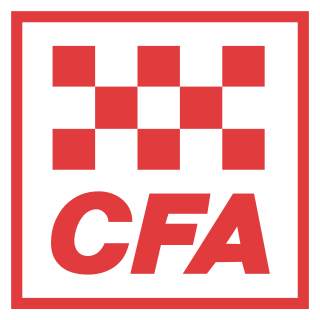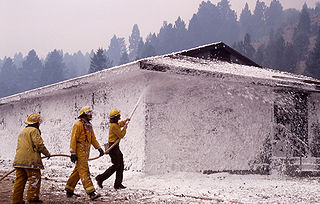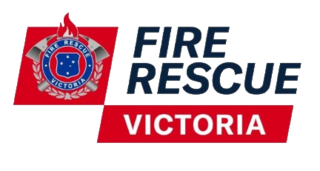Related Research Articles

A firefighter is a rescuer extensively trained in firefighting, primarily to extinguish hazardous fires that threaten life, property, and the environment as well as to rescue people and in some cases or jurisdictions also animals from dangerous situations. Male firefighters are sometimes colloquial referred to by the disregarded but historical term fireman and rarely a female firefighter as a firewoman by uneducated nonprofessionals, the use of the now nonstandard terminology is discouraged.

A boiling liquid expanding vapor explosion is an explosion caused by the rupture of a vessel containing a pressurized liquid that has reached temperatures above its boiling point. Because the boiling point of a liquid rises with pressure, the contents of the pressurized vessel can remain liquid so long as the vessel is intact. If the vessel's integrity is compromised, the loss of pressure and dropping boiling point can cause the liquid to rapidly convert to gas and expand extremely rapidly. If the gas is combustible as well, as is the case e.g. with hydrocarbons and alcohols, further damage can be caused by an ensuing fire.

Firefighting is the act of attempting to prevent the spread of and extinguish significant unwanted fires in buildings, vehicles, woodlands, etc. A firefighter suppresses fires to protect lives, property and the environment.
Santos Ltd. is an Australian energy company, the country's second-largest independent oil and gas producer. In the 2020 Forbes Global 2000, Santos was ranked as the 1583rd -largest public company in the world.
Firefighting jargon includes a diverse lexicon of both common and idiosyncratic terms. One problem that exists in trying to create a list such as this is that much of the terminology used by a particular department is specifically defined in their particular standing operating procedures, such that two departments may have completely different terms for the same thing. For example, depending on whom one asks, a safety team may be referred to as a standby, a RIT or RIG or RIC, or a FAST. Furthermore, a department may change a definition within its SOP, such that one year it may be RIT, and the next RIG or RIC.

The Country Fire Authority (CFA) is a volunteer fire service responsible for fire suppression, rescues, and response to other accidents and hazards across most of the state Victoria, Australia. CFA comprises over 1,200 brigades organised in 21 districts, and shares responsibility for fire services with Fire Rescue Victoria, which employs full-time paid firefighters in major urban areas; and Forest Fire Management Victoria (FFMV), which manages fire prevention and suppression on Victoria's public lands. CFA operations and equipment are partly funded by the Victorian Government through its Fire Services Levy, and supplemented by individual brigades' fundraising for vehicles and equipment.
The New Zealand Fire Service was New Zealand's main firefighting body from 1 April 1976 until 1 July 2017 – at which point it was dissolved and incorporated into the new Fire and Emergency New Zealand.

Firefighting foam is a foam used for fire suppression. Its role is to cool the fire and to coat the fuel, preventing its contact with oxygen, resulting in suppression of the combustion. Fire-fighting foam was invented by the Russian engineer and chemist Aleksandr Loran in 1902.

RAAF Base Rathmines is a heritage-listed former RAAF WWII seaplane base and now used as community venues, sports venues and a visitor attraction at Dorrington Road, Rathmines, City of Lake Macquarie, New South Wales, Australia. It was in use as an RAAF base from 1939 to 1961. It is also known as Rathmines Park, former RAAF Seaplane Base, Flying Boat Base, Rathmines Aerodrome and Catalina Base. The property is owned by Australian Christadelphian Bible School, Disability Life Enrichment, Don Geddes Nursing Home and Lake Macquarie City Council. The remains of the former air base was added to the New South Wales State Heritage Register on 25 November 2005.

Fire and Rescue NSW, an agency of the Government of New South Wales, Australia, is responsible for firefighting, rescue and hazmat services in the major cities, metropolitan areas and towns across New South Wales. Fire and Rescue NSW is the fourth largest urban fire service in the world, with over 6,800 firefighters serving at 335 fire stations throughout the state, supported by 465 administrative and trades staff and 5,700 community fire unit volunteers. FRNSW are also the busiest fire service in Australia, attending over 124,000 incidents a year.

Vancouver Fire Rescue Services (VFRS) was founded in 1886 and today serves the city of Vancouver, British Columbia providing fire, medical first response, rescue and extrication services. In 2017, VF&RS responded to 67,000 emergency calls.

Essex County Fire and Rescue Service (ECFRS) is the statutory fire and rescue service for the county of Essex in the east of England, and is one of the largest fire services in the country, covering an area of 1,338 square miles (3,470 km2) and a population of over 1.7 million people.

The London Fire Brigade, one of the largest fire and rescue services in the world, operates a large and diverse fleet of vehicles, known as appliances, all carrying a varied range of specialised equipment and apparatus for use in firefighting and rescue operations.
Firefighting is the act of extinguishing destructive fires. A firefighter fights these fires with the intent to prevent destruction of life, property and the environment. Firefighting is a highly technical profession, which requires years of training and education in order to become proficient. A fire can rapidly spread and endanger many lives; however, with modern firefighting techniques, catastrophe can usually be avoided. To help prevent fires from starting, a firefighter's duties include public education and conducting fire inspections. Because firefighters are often the first responders to victims in critical conditions, firefighters often also provide basic life support as emergency medical technicians or advanced life support as licensed paramedics. Firefighters make up one of the major emergency services, along with the emergency medical service, the police, and many others.

On May 9, 2008, three Dutch firefighters lost their lives tackling a blaze at a large commercial building situated in a shipyard in the village of De Punt in the Dutch province of Drenthe. The firefighters, Anne Kregel, Raymond Soyer and Egbert Ubels entered the building not knowing that a layer of highly combustible smoke and gas had built up under the roof. This ignited, resulting in a sudden spread of the fire accompanied by a major explosion that resulted in their deaths.

The Scottish Fire and Rescue Service is the national fire and rescue service of Scotland. It was formed by the merger of eight regional fire services in the country on 1 April 2013. It thus became the largest fire brigade in the United Kingdom, surpassing the London Fire Brigade.
The Scottish Fire Service College, later known as the Scottish Fire and Rescue Service College Gullane, was a training facility located in East Lothian that operated from 1954 to 2015. A former hotel building, it was used for the initial training for new recruits from across Scotland and also for other specialist training. The facility at Gullane closed in 2015, shortly after the eight separate Scottish fire services merged in April 2013 to form the Scottish Fire and Rescue Service (SFRS), and a new national specialist training centre opened in Cambuslang.
The Victorian Emergency Management Training Centre (VEMTC) is a training facility for volunteer and career emergency services personnel. It used by the Metropolitan Fire Brigade, the Country Fire Authority (CFA), Victoria Police, Ambulance Victoria, Victoria State Emergency Service and the Department of Environment, and Primary Industries. The centre is located in Melbourne's north in Craigieburn,

Fire Rescue Victoria (FRV) is a fire and rescue service in the state of Victoria in Australia that serves the capital Melbourne and major regional centres throughout Victoria. FRV operates 85 fire stations with full-time staff firefighters, around half of which are in the Melbourne metropolitan area, and the remainder in regional cities and large towns throughout the state. 34 of these stations which are classified as peri-urban and regional stations, are co-located with volunteer brigades of the Country Fire Authority (CFA). FRV was formed on 1 July 2020 by a merger of the Metropolitan Fire Brigade (MFB), a fully career service responsible for much of the Greater Melbourne area, with the 1400 career firefighters of the CFA, some of whom had operated in "integrated" staff and volunteer brigades on the Melbourne urban fringe and in other centres. FRV Deputy Commissioner Ken Block stated on 1 July 2020 that under the CFA and MFB merge; Fire Rescue Victoria is now made up of more than 3600 operational firefighters.

On 14 June 2017, a fire broke out in the 24-storey Grenfell Tower block of flats in North Kensington, West London, at 00:54 BST; it caused 72 deaths, including those of two victims who later died in hospital. More than 70 others were injured and 223 people escaped. It was the deadliest structural fire in the United Kingdom since the 1988 Piper Alpha disaster and the worst UK residential fire since the Second World War.
References
- ↑ Ballarat Tourism's CFA webpage. Accessed 21 November 2008 Archived 24 July 2008 at the Wayback Machine
- ↑ CFA knew of Fiskville training centre contamination, inquiry finds The Age 24 May 2016
- ↑ Fiskville inquiry: Allegations water 'deliberately contaminated' at Victorian firefighting training base ABC News, 15 June 2015
- ↑ Fiskville report: Firefighters deserve 'justice' over toxic CFA training facility, report finds ABC News 24 May 2016
- ↑ Fiskville inquiry: Former fire chief denies railroading family into accepting compensation offer ABC News 28 January 2016
- ↑ Martin, Steve (26 March 2015). "Keep Fiskville Open Campaign". The Morning Show. ABC Radio. 774 ABC Melbourne. Archived from the original on 11 July 2015. Retrieved 14 August 2015.
- ↑ CFA Fiskville Training Centre Page. Accessed 21 November 2008 Archived 26 December 2008 at the Wayback Machine
- ↑ "CFA Fiskville whistleblower Brian Potter dies". ABC News. 13 February 2014. Retrieved 3 March 2015.
- ↑ Fiskville report: Firefighters deserve 'justice' over toxic CFA training facility, report finds
- ↑ "Baillieu to call inquiry into suspected cancer cluster at Fiskville". Herald Sun. 7 December 2011. Retrieved 3 March 2015.
- ↑ "Response to the Professor Joy Report of the Independent Investigation into the CFA Facility at Fiskville" (PDF). Country Fire Authority. Archived from the original (PDF) on 3 April 2015. Retrieved 3 March 2015.
- ↑ Fiskville Independent Report Summary (Part 1) YouTube video
- ↑ Fiskville Firefighters' Health Study Archived 22 January 2015 at the Wayback Machine Monash Centre for Occupational and Environmental Health, Department of Epidemiology and Preventive Medicine
- ↑ Cluster Found at Infamous Fire Facility http://www.premier.vic.gov.au/cancer-cluster-found-at-infamous-fire-facility
- ↑ "Fiskville CFA fire-training facility closed indefinitely after chemical residue found in water". ABC News. 3 March 2015. Retrieved 3 March 2015.
- ↑ CFA knew of Fiskville training centre contamination, inquiry finds The Age 24 May 2016